The Health Education Assets Library (HEAL) is a collection of over 22,000 freely available digital materials for health sciences education. The collection is now housed at the University of Utah J. Willard Marriott Digital Library.
TO
Filters: Collection: "ehsl_heal"
| Title | Description | Subject | Collection | ||
|---|---|---|---|---|---|
| 151 |
 |
Peroxidase reaction in reticular cell and myelocytes (postnatal liver, rat) | Electron microscopy (peroxidase reaction with diaminobenzidin staining). The elongated reticular cell (1) shows peroxidase activity within the perinuclear space as well as the rough endoplasmic reticulum (species-dependent). It is surrounded by three eosinophilic myelocytes (2) with a positive react... | Poja Histology Collection - Blood & Bone Marrow Subset | |
| 152 |
 |
Peroxidase staining of granulocytes in peripheral blood smear (human) | Stain: peroxydase staining with DAB (diaminobenzidin). Blood smear showing two strongly positively stained granulocytes and one negative lymphocyte. The (myelo-) peroxidase activity is localized in the granules. | Poja Histology Collection - Blood & Bone Marrow Subset | |
| 153 |
 |
Phagocytosis of latex by neutrophil (peripheral blood, human) | Electron microscopy. The primary function of neutrophilic granulocytes is phagocytosis, ingestion of and destroying microbes or, as shown here, of latex particles. Several electron-light latex particles (1) (with a dense core) are internalized after incubation of free circulating granulocytes with a... | Poja Histology Collection - Blood & Bone Marrow Subset | |
| 154 |
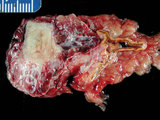 |
Pheochromocytoma adjacent to adrenal gland | This is a gross photograph of a paranganglioma (pheochromocytoma) adjacent to the adrenal gland. | HEAL Reviewed Collection | |
| 155 |
 |
Plasma cell | Scheme electron microscopy. The mature plasma cell or plasmacyte (12-15 m) shows an eccentric nucleus (1) with a characteristic chunky distribution of heterochromatin along the inner nuclear membrane ('spoke-wheel' effect in light microscopy). Juxta-nuclearly an elaborate Golgi area (2) with secreti... | Poja Histology Collection - Blood & Bone Marrow Subset | |
| 156 |
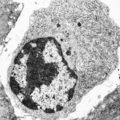 |
Plasma cell (liver, rat) | Electron microscopy. The mature plasma cell or plasmacyte shows an eccentric nucleus with a characteristic chunky distribution of heterochromatin along the inner nuclear membrane (spoke-wheel effect in light microscopy). Juxtanuclearly an elaborate Golgi area (2) (cytocentrum/centrosome). The cytopl... | Poja Histology Collection - Blood & Bone Marrow Subset | |
| 157 |
 |
Plasma cell in bone marrow smear (human) | Stain: May-Grnwald-Giemsa (MGG). (1) A plasma cell with vacuoles (containing Ig), basophilic cytoplasm and a clear halo (Golgi apparatus) in a bone marrow film. (2) represents a young polychromatic erythroblast. (3) neutrophilic myelocyte, and (4) is a cluster of platelets. | Poja Histology Collection - Blood & Bone Marrow Subset | |
| 158 |
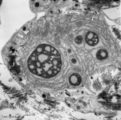 |
Plasma cell with Russell bodies (nose septum, rat) | Electron microscopy. This mature plasma cell exhibits in the cytoplasm dilated rough endoplasmic reticulum (1) filled with electron-grey material as well as electron-dense granules (2) of varying sizes (antibodies). These electron-dense granules are made up of accumulated (crystallin) immunoglobulin... | Poja Histology Collection - Blood & Bone Marrow Subset | |
| 159 |
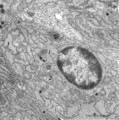 |
Plasma cells (spleen, mouse) | Electron microscopy. The mature plasma cell shows an eccentric nucleus with a characteristic chunky distribution of heterochromatin along the inner nuclear membrane ('spoke-wheel' effect in light microscopy). Juxta-nuclearly an elaborate Golgi area (2) with secretion vacuoles is localized (cytocentr... | Poja Histology Collection - Blood & Bone Marrow Subset | |
| 160 |
 |
Plasma cells in bone marrow smear (human) | Stain: May-Grnwald-Giemsa (MGG). The two plasma cells are mature antibody-producing cells. The basophilic cytoplasm is filled up with rough endoplasmic reticulum (RER). The lighter zone (1) represents the Golgi areas. The nucleus is situated eccentrically and contains strands of condensed chromatin ... | Poja Histology Collection - Blood & Bone Marrow Subset | |
| 161 |
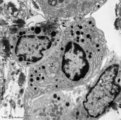 |
Plasma cells with Russell bodies (nose septum, rat) | Electron microscopy. Accumulation of few plasma cells. These mature plasma cells exhibit in their cytoplasm's dilated rough endoplasmic reticula (1) filled with electron-grey material (antibodies) as well as electron-dense granules (3) of varying sizes confirming their secretory activities. (2) indi... | Poja Histology Collection - Blood & Bone Marrow Subset | |
| 162 |
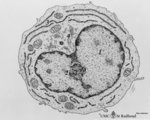 |
Plasmablast | Scheme electron microscopy. This plasmablast (up to 20 μm) shows an indented large nucleus (1) and a distinct nucleolus (2). In addition to free ribosomes long profiles of rough endoplasmic reticulum (RER) (3) are being developed concomitant with Golgi packages (4). The cytoplasm is scanty with few... | Poja Histology Collection - Blood & Bone Marrow Subset | |
| 163 |
 |
Plasmablast in peripheral blood smear (human) | Stain: May-Grnwald-Giemsa (MGG). The oval shaped cell with a slightly excentric nucleus and coarsely clumped chromatin has a basophilic blue cytoplasm in which the Golgi area usually remains unstained (white area). | Poja Histology Collection - Blood & Bone Marrow Subset | |
| 164 |
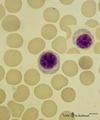 |
Plasmacytoid lymphocytes (activated B cells) in peripheral blood smear (human) | Stain: May-Grnwald-Giemsa (MGG). Two different plasmacytoid lymphocytes or activated young B cells (up to 15 μm) contain a dark-stained nucleus and a slightly basophilic cytoplasm with a kind of a 'nuclear hof' indicating the Golgi area. These cells will develop into plasma cells. | Poja Histology Collection - Blood & Bone Marrow Subset | |
| 165 |
 |
Platelets | Scheme electron microscopy. These disc-shaped anucleate cells (2-4 m) are derived from cytoplasmic fragments of the megakaryocyte. They contain few mitochondria, a canalicular system, a smooth tubular system, marginal localized microtubules, glycogen and different types of granula. A circumferential... | Poja Histology Collection - Blood & Bone Marrow Subset | |
| 166 |
 |
Platelets (peripheral blood, human) | Electron microscopy. These anucleate cells (2-4 μm) are derived from cytoplasmic fragments of a megakaryocyte and when free floating in the peripheral blood they develop thin extensions. These platelets contain among others few mitochondria (1), microtubules (2), glycogen (3), small vacuoles (4, op... | Poja Histology Collection - Blood & Bone Marrow Subset | |
| 167 |
 |
Platelets (peripheral blood, human) | Electron microscopy. These disc-shaped cells (2-4 m) without nucleus are derived from cytoplasmic fragments of the megakaryocyte. Free floating in the peripheral blood they develop thin extensions. They contain among others few mitochondria, smooth tubular systems, marginal localized microtubules, g... | Poja Histology Collection - Blood & Bone Marrow Subset | |
| 168 |
 |
Platelets in peripheral blood smear (human) | Stain: May-Grnwald-Giemsa (MGG). The platelets or thrombocytes are small cell fragments released from megakaryocytes. The platelets (→) measure 1-3 μm in diameter. They contain fine azurophilic granules which may be dispersed throughout the cytoplasm or concentrated in the centre; in the latter c... | Poja Histology Collection - Blood & Bone Marrow Subset | |
| 169 |
 |
Pleiomorph bone marrow smear (human) | Stain: May-Grnwald-Giemsa (MGG). Low power view of a normal bone marrow smear. The bone marrow is pleiomorph and contains all cell types such as a large reticulum cells (1) with many granules or lysosomes (phagocytosis); myeloid cells (2); and erythroblasts (3). | Poja Histology Collection - Blood & Bone Marrow Subset | |
| 170 |
 |
Pleiomorph normal bone marrow smear (human) | Stain: May-Grnwald-Giemsa (MGG). The normal bone marrow with pleiomorphism, i.e. contains all stages of the erythroblastic differentiation series (1-5) as well as the stages of the myeloblastic series (6). (1) Basophilic erythroblast. (2),(3),(4) Polychromatic erythroblasts. (5) Orthochromatic er... | Poja Histology Collection - Blood & Bone Marrow Subset | |
| 171 |
 |
Polychromatic erythroblasts (bone marrow, rabbit) | Electron microscopy. Shown are two polychromatic erythroblasts or intermediate normoblasts between other erythroblasts and reticulocytes (2). Few mitochondria and polysomes are present but there is a decrease in amount of all organelles and nuclear clumping starts to take place. During this maturing... | Poja Histology Collection - Blood & Bone Marrow Subset | |
| 172 |
 |
Polychromatic erythroblasts and neutrophilic granulocytes in bone marrow smear (human) | Stain: May-Grnwald-Giemsa (MGG). Three polychromatic erythroblasts or normoblasts (1) and two neutrophils (2). The erythroblasts show light basophilic cytoplasm and well condensed nuclear chromatin. The lower neutrophil (more mature) has a more segmented nucleus than the upper one. | Poja Histology Collection - Blood & Bone Marrow Subset | |
| 173 |
 |
Polycythemia in bone marrow smear (human) | Stain: Hematoxylin and eosin. Low power view. Polycythemic phase. Hypercellular marrow as a result of excessive proliferation of erythroid cells (numerous dark nuclei) and of the megakaryocytic lineage (tendency to cluster). (1) fat cells in bone marrow. (2) megakaryocytes. (3) erythropoietic cell t... | Poja Histology Collection - Blood & Bone Marrow Subset | |
| 174 |
 |
Pro-megakaryocyte | Scheme electron microscopy. The pro-megakaryocyte (20-80 m) develops from a basophilic megakaryoblast (up to 50 m) that originates from a committed stem cell. The large pro-megakaryocyte starts with the early synthesis of the characteristic granules of platelets. Apart from a bilobed nucleus (1) and... | Blood; Bone Marrow; Electron microscopy; Pro-megakaryocyte; Megakaryocyte | Poja Histology Collection - Blood & Bone Marrow Subset |
| 175 |
 |
Proerythroblast and eosinophilic metamyelocyte in bone marrow smear (human) | Stain: May-Grnwald Giemsa (MGG). The late proerythroblast (1) has a deep blue-stained basophilic cytoplasm and so called ears (→, slight bulging) of sidewards accumulated ribosomes (in electron microscopy) in the cytoplasm. The eosinophilic metamyelocyte (2) has characteristic large, solitary brow... | Poja Histology Collection - Blood & Bone Marrow Subset |
